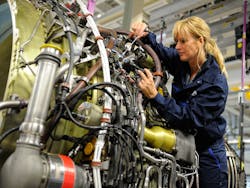FAA researchers consider jet aircraft engine vibration monitoring to indicate threats to passenger safety
ATLANTIC CITY, N.J. – U.S. aviation safety experts are reaching out to industry to find companies able to detect abnormal aircraft engine vibration that could lead to severe engine or aircraft damage that could threaten passenger safety.
Officials of the U.S. Federal Aviation Administration (FAA) Airport Safety Research and Development Section at the FAA William J. Hughes Technical Center in Atlantic City, N.J., issued a sources-sought notice on Friday (692M15-23-Engine-Vibration-Failure) for the Aircraft Engine Vibration Alerting For Failure Mitigation project.
This two-year project seeks to evaluate normal and abnormal vibration levels and broadband signatures on aircraft engines during engine development, certification testing, and in airline service to determine deviation from normal that could indicate dangerous engine behavior.
FAA researchers are extending the deadline for responding to this sources-sought notice to 28 March 2023. The notice originally came out on 10 March 2023.
Related: FAA seeks methodology to flag abnormal engine vibrations and broadband signatures
The project seeks to demonstrate how to generate alerts or advisories for abnormal vibration and inform maintenance inspections so they can take measures to avoid progression to a more severe engine or jet aircraft damage condition or potential hazard to passenger safety.
Several engine models from different passenger aircraft engine designers have experienced engine and sometimes aircraft damage due to engine internal failures like partial blade loss, seal cracks or breaks, or anomalies like excessive wear due to undetected manufacturing assembly errors.
Some of these failures, which can be related to abnormal vibration levels, have led to airline fleet disruptions, airworthiness directives, and federal investigations.
Related: Meeting SWaP needs for electronics and sensors for hypersonic flight
To fix these problems, FAA researchers are looking for a company to study engine vibration levels and broadband signatures to develop detection thresholds and alerting strategies.
The contractor must show how to provide alerts or advisories of abnormal vibration levels and signatures and to prompt maintenance decisions to avoid progression of the condition to a more severe damage level.
This will entail participation by engine designers with many engines on aircraft such as the Boeing 737, 787, 777, as well as the Airbus A320, A330, A350, with on-board broadband vibration measurement and analysis capability.
Related: Common technologies for manned and unmanned aircraft
The contractor chosen will quantify synchronous and nonsynchronous vibration levels and signatures for rotors in about 30 separate engines during takeoff, climb, and cruise over time and in different operating conditions to determine a baseline of the normal variation in vibration levels for comparison to the levels seen in malfunctions.
Companies interested should email capability statements, detailed descriptions of proposed solutions, examples of previous contracts, business size, and rough order of magnitude of costs no later than 28 April to the FAA's Joseph Szwec at [email protected].
More information, including a draft statement of work, is online at https://sam.gov/opp/d6bee90bdccc4f10b62397156ef91781/view.

John Keller | Editor-in-Chief
John Keller is the Editor-in-Chief, Military & Aerospace Electronics Magazine--provides extensive coverage and analysis of enabling electronics and optoelectronic technologies in military, space and commercial aviation applications. John has been a member of the Military & Aerospace Electronics staff since 1989 and chief editor since 1995.

